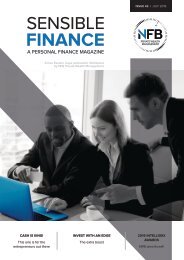NVFH 2020 Integrated Annual Report
Create successful ePaper yourself
Turn your PDF publications into a flip-book with our unique Google optimized e-Paper software.
NVest Financial Holdings Limited and its subsidiaries | (Registration number 2008/015990/06)
Annual Financial Statements for the year ended 29 February 2020
Accounting Policies [continued]
1.7 Financial instruments [continued]
recovery of part of the cost of the investment. Dividends are
included in investment income (note 25).
Borrowings, loans from related parties and trade and other
payables
Classification
Loans from related parties (note 10) and borrowings (note 18)
are classified as financial liabilities subsequently measured at
amortised cost.
Trade and other payables (note 19), excluding VAT and
amounts received in advance, are classified as financial
liabilities subsequently measured at amortised cost.
Recognition and measurement
Borrowings, loans from related parties and trade and other
payables are recognised when the group becomes a party
to the contractual provisions, and are measured, at initial
recognition, at fair value plus transaction costs, if any.
They are subsequently measured at amortised cost using the
effective interest method.
The effective interest method is a method of calculating
the amortised cost of a financial liability and of allocating
interest expense over the relevant period. The effective
interest rate is the rate that exactly discounts estimated
future cash payments (including all fees and points paid or
received that form an integral part of the effective interest
rate, transaction costs and other premiums or discounts)
through the expected life of the financial liability, or (where
appropriate) a shorter period, to the amortised cost of a
financial liability.
If trade and other payables contain a significant financing
component, and the effective interest method results in the
recognition of interest expense, then it is included in profit or
loss in finance costs (note 26).
Trade and other payables expose the group to liquidity risk
and possibly to interest rate risk. Refer to note 33 for details of
risk exposure and management thereof.
Interest expense, calculated on the effective interest
method, is included in profit or loss in finance costs (note 26.)
Borrowings expose the group to liquidity risk and interest
rate risk. Refer to note 33 for details of risk exposure and
management thereof.
Derecognition
Refer to the “derecognition” section of the accounting policy
for the policies and processes related to derecognition.
Cash and cash equivalents
Cash and cash equivalents are initially measured at fair
value, and are subsequently measured at amortised cost.
Derecognition
Financial assets
The group derecognises a financial asset only when the
contractual rights to the cash flows from the asset expire, or
when it transfers the financial asset and substantially all the
risks and rewards of ownership of the asset to another party.
If the group neither transfers nor retains substantially all the
risks and rewards of ownership and continues to control the
transferred asset, the group recognises its retained interest
in the asset and an associated liability for amounts it may
have to pay. If the group retains substantially all the risks and
rewards of ownership of a transferred financial asset, the group
continues to recognise the financial asset and also recognises
a collateralised borrowing for the proceeds received.
Financial liabilities
The group derecognises financial liabilities when, and only
when, the group obligations are discharged, cancelled or
they expire. The difference between the carrying amount
of the financial liability derecognised and the consideration
paid and payable, including any non-cash assets transferred
or liabilities assumed, is recognised in profit or loss.
1.8 Tax
Current tax assets and liabilities
Current tax for current and prior periods is, to the extent
unpaid, recognised as a liability. If the amount already paid
in respect of current and prior periods exceeds the amount
due for those periods, the excess is recognised as an asset.
Current tax liabilities (assets) for the current and prior periods
are measured at the amount expected to be paid to
(recovered from) the tax authorities, using the tax rates (and
tax laws) that have been enacted or substantively enacted
by the end of the reporting period.
Deferred tax assets and liabilities
A deferred tax liability is recognised for all taxable temporary
differences, except to the extent that the deferred tax
liability arises from the initial recognition of an asset or liability
in a transaction which at the time of the transaction, affects
neither accounting profit nor taxable profit (tax loss).
A deferred tax asset is recognised for all deductible
temporary differences to the extent that it is probable that
taxable profit will be available against which the deductible
temporary difference can be utilised. A deferred tax asset is
not recognised when it arises from the initial recognition of an
asset or liability in a transaction at the time of the transaction,
affects neither accounting profit nor taxable profit (tax loss).
A deferred tax asset is recognised for the carry forward of
unused tax losses to the extent that it is probable that future
taxable profit will be available against which the unused tax
losses can be utilised.
NVest Financial Holdings Limited | INTEGRATED ANNUAL REPORT 2020 89






